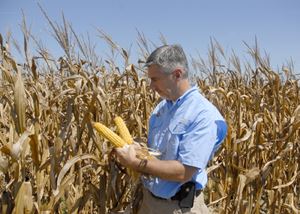Corn Defies Odds, Approaches Record
MISSISSIPPI STATE, Miss.
Mississippi growers’ determination to plant corn last spring is paying
off as harvests approach 2012’s record yields of 165 bushels per acre.
Persistent rains and low temperatures in the spring delayed planting,
slowed emergence and contributed to less than desirable final stands.
Cool weather through May also slowed corn growth and maturity by about
two weeks throughout the season.
Jerry Singleton, area agent in Leflore County with the Mississippi State
University Extension Service, said he is almost afraid to say how good
the yields appear to be.
“I think averages are going to be over 200 bushels per acre on some
irrigated farms,” he said. “The early rains made it hard to get into
fields, either to plant or apply nitrogen in a timely manner, but after
that, conditions were just right and not too hot.”
Erick Larson, state Extension corn specialist, said the crop is proving to be more productive than expected.
“Overall, corn yields have been extremely positive, which is a very
pleasant surprise for both dryland and irrigated fields, but harvest
progress is well behind normal and especially behind last year’s
exceptionally early crop,” he said. “Some areas benefitted from timely
summer rainfall, but the most significant factor enhancing corn yields
was uncommonly mild night temperatures during June and July. This
allowed corn plants to utilize energy much more efficiently for grain
production.”
Larson said corn maturity is determined by heat unit accumulation. Late
plantings and a cool spring combined to delay this crop’s maturity.

“Growers across Mississippi planted corn over a lot wider time frame
than normal, and many intended acres were not planted due to frequent
spring rains. Corn planting began in early March and continued until
late May in some instances,” he said. “Cool spring temperatures also
slowed crop maturation, so we were extremely blessed to experience much
milder temperatures and some timely rainfall this summer.”
Larson said most growers are now anxious to harvest the delayed crop to
avoid rains that could threaten grain quality or storms that could blow
stalks over. However, he warned that rushing to harvest high-moisture
grain could have drawbacks.
“Growers get docked if they bring high-moisture corn to grain elevators
as high-moisture grain is not safe to store long term. If Mother Nature
doesn’t dry the corn, then it must be dried artificially,” he said.
“Growers are also storing more grain on farm in grain bins, but moist
grain and high temperatures inherent this time of year present
substantial risk and require intense management and normally specialized
equipment to quickly dry grain for safe storage.”
Although progress is well behind schedule, recent hot, dry weather is now promoting a swift corn harvest.
“Parts of the south Delta are 85-90 percent finished harvesting by the
first few days in September, but that tails off north of Highway 82,”
Larson said.
Dennis Reginelli, Extension agronomics crops agent, said yields in the Noxubee County area have been varied but generally good.
“We are harvesting good yields at this point with dryland averaging
180-230 bushels per acre,” he said. “Timely rains helped keep dryland
and irrigated fields closer in production. Some years there are 80-100
bushels more per acre in irrigated fields. This year, the difference is
closer to 20 bushels per acre.”
Brian Williams, assistant Extension professor of agricultural economics,
said although prices are the lowest they have been since 2010, they
remain fairly good from a historical perspective, especially with strong
yields predicted.
“Many of the analysts are expecting the U.S. crop to be a record this
year. December futures are running around $4.61 per bushel,” he said.
“As recently as late June, we had prices for September futures exceeding
$6 per bushel.” ∆